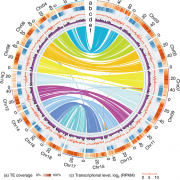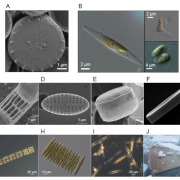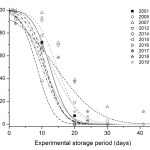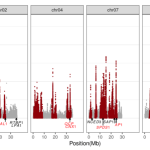Concerted expansion and contraction of immune receptor gene repertoires in plant genomes (Nature Plants)
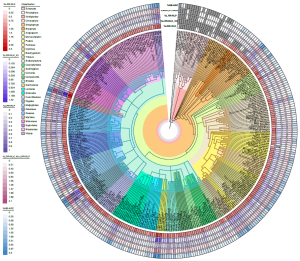 Plant immunity is crucial for adaptation to pathogen attack and subsequent survival. Two systems support plant immunity. Cell-surface pattern-recognition receptors (PRRs) recognize pathogen-associated molecular patterns (PAMPs) and prompt pattern-triggered immunity. Intracellular nucleotide-binding leucine-rich repeat (NLR) receptors are activated by pathogen effectors and cause effector-triggered immunity. Ngou et al. examined genomes from 350 plant species including 26 algal species, 5 bryophytes, 10 gymnosperms and 300 angiosperms. The authors found that expansion/contraction of NLRs is correlated with similar expansion/contraction of PRRs. They suggeste that this expansion/contraction is effected by pathogen pressure, ecological niche, and plant growth habits. Genera with highest percentage PRRs and NLR-associated domains included Triticum and Oryza, likely associated with their densely growing populations and airborne pathogens. Tree species similarly exhibited high percentage PRRs and NLR-associated domains, which may be linked with extended lifespan and associated pathogen exposure in these species. As this coordination of immune receptor expansion and contraction is not caused by genetic clustering, future work may determine what coordination mechanism is controlling this process in plant genomes. (Summary by Orla Sherwood, @orlasherwood) Nature Plants. 10.1038/s41477-022-01260-5
Plant immunity is crucial for adaptation to pathogen attack and subsequent survival. Two systems support plant immunity. Cell-surface pattern-recognition receptors (PRRs) recognize pathogen-associated molecular patterns (PAMPs) and prompt pattern-triggered immunity. Intracellular nucleotide-binding leucine-rich repeat (NLR) receptors are activated by pathogen effectors and cause effector-triggered immunity. Ngou et al. examined genomes from 350 plant species including 26 algal species, 5 bryophytes, 10 gymnosperms and 300 angiosperms. The authors found that expansion/contraction of NLRs is correlated with similar expansion/contraction of PRRs. They suggeste that this expansion/contraction is effected by pathogen pressure, ecological niche, and plant growth habits. Genera with highest percentage PRRs and NLR-associated domains included Triticum and Oryza, likely associated with their densely growing populations and airborne pathogens. Tree species similarly exhibited high percentage PRRs and NLR-associated domains, which may be linked with extended lifespan and associated pathogen exposure in these species. As this coordination of immune receptor expansion and contraction is not caused by genetic clustering, future work may determine what coordination mechanism is controlling this process in plant genomes. (Summary by Orla Sherwood, @orlasherwood) Nature Plants. 10.1038/s41477-022-01260-5



